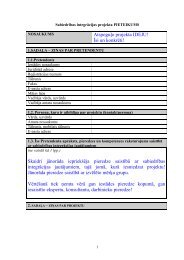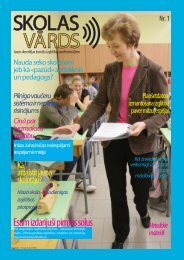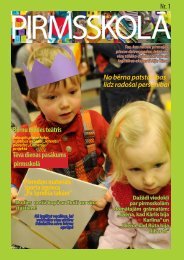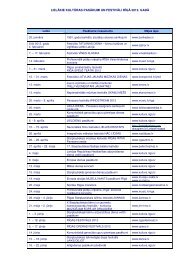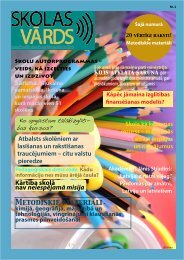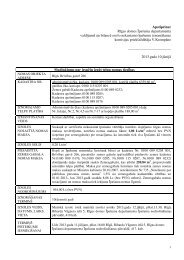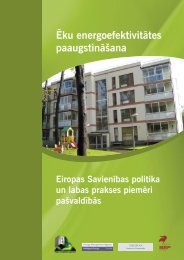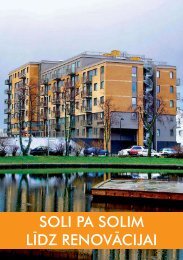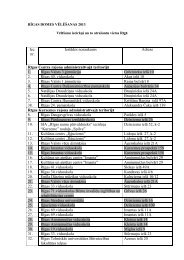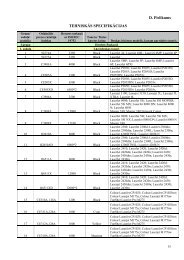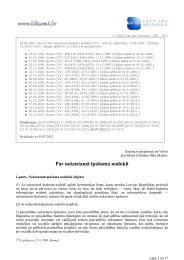Riga - European Capital of Culture 2014 candidate
Riga - European Capital of Culture 2014 candidate
Riga - European Capital of Culture 2014 candidate
- No tags were found...
You also want an ePaper? Increase the reach of your titles
YUMPU automatically turns print PDFs into web optimized ePapers that Google loves.
freedom streetWhen a ruling power changes, and in <strong>European</strong> history thishas usually happened after a revolution or war, the firstthing that power does is to change the names <strong>of</strong> streets.Freedom Street, within the context <strong>of</strong> the <strong>Riga</strong> as <strong>European</strong><strong>Capital</strong> <strong>of</strong> <strong>Culture</strong> programme, is not just the story <strong>of</strong> astreet. Freedom Street is a symbolic stage, a system <strong>of</strong>signs, a tale <strong>of</strong> history and wars, which we can say onlyended yesterday, even though perhaps a whole century haselapsed.The “Freedom Street” programme which refers to the centenary<strong>of</strong> the 1 st World War, is intended as a story <strong>of</strong> collisions, which peoplewho live in any city in any place in the world experience. <strong>Riga</strong>’shistory is one such space for collisions, where echoes <strong>of</strong> globalhistorical events can be found. Over the entire course <strong>of</strong> the 20 thcentury <strong>Riga</strong> has found itself in postwar-prewar relationships, orloser-winner relationships, but the local people’s memories <strong>of</strong> historicalevents have not been inherited – they are alive and real, justas in the consciousness <strong>of</strong> many <strong>European</strong>s.Freedom Street has experienced a lot. Power and war have alwayssought acknowledgement in this street, changing or not changingits name. Freedom Street is the axis <strong>of</strong> the city <strong>of</strong> <strong>Riga</strong>, the mainstreet (Via Magna), which has been called Large Sand Street,Aļeksandrovskij buļvar, Petrogradskoje šosse, Revolution Street,Adolf Hitler Strasse, Lenin Street and finally – Freedom Street oncemore. In <strong>2014</strong> the street will regain its historic names in the form<strong>of</strong> artistic events along its entire length, above all stressing theinvaluable virtue <strong>of</strong> freedom and democracy.Freedom Street is the stage for the history <strong>of</strong> global power. Itis the story <strong>of</strong> one <strong>European</strong> city’s and its inhabitants’ relationshipwith power – invincible and at the same time overcome. The1 st World War, which dates back 100 years before <strong>2014</strong>, and itsconsequences, in the interpretations <strong>of</strong> many <strong>European</strong> historiansends around the time when <strong>Riga</strong>’s main street retrieved itsname <strong>of</strong> Freedom. In 1914, <strong>Riga</strong> was one <strong>of</strong> the group <strong>of</strong> citiesthat formed part <strong>of</strong> the indisputable <strong>European</strong> prestige, which,together with the 1 st World War, Europe lost, leaving indelible consequencesin the consciousness <strong>of</strong> <strong>European</strong>s. <strong>Riga</strong>, in war-time,has always been drawn in between other powers. And FreedomStreet is also this type <strong>of</strong> axis - between East and West, betweenother powers. Freedom Street has experienced several wars –First World War, Second World War, Cold War, Singing Revolution,August 1991 putsch. Many military forces have entered and left<strong>Riga</strong> via this street. War has its reflections in the cultural code <strong>of</strong>Europe, which has also defined cultural mobility, destroying andcommanding resurrection anew. It has always exploited the cityfor its own gains, demonstrated itself in the main street <strong>of</strong> any<strong>European</strong> capital city. In a way, for <strong>Riga</strong>, the 1 st World War endedin 1991.Prewar and postwar periods have taken <strong>European</strong> culture, homes,places, people, generations, stories, memories, monuments andspirit, facilitating progress and always – on someone’s account.Freedom Street is a stage for both destruction and renewal. Thefeminine and the masculine. Collisions and war never end, theyjust continue the search for fresh forms <strong>of</strong> acknowledgement. Thegreatest philosopher on freedom in the world, Sir Isaiah Berlin, wasborn in <strong>Riga</strong> and taken for walks by his nanny on the Esplanade byFreedom Street (then - Aļeksandrovskij Buļvar). Paradoxically, hischildhood promenade place, the Esplanade, during his lifetimeand later, became the location for military parade rituals. Freedomis a symbol and a value, which becomes these things preciselyas the result <strong>of</strong> an invincible force (force majeure). When Berlinwas asked whether the focus <strong>of</strong> his thoughts was influenced bythe fact that he was born in the Russian province <strong>of</strong> <strong>Riga</strong> duringits period <strong>of</strong> sophistication and peak period <strong>of</strong> development andafter leaving <strong>Riga</strong> experienced the revolution in Petersburg, hereplied that this was undoubtedly true. A place always leaves itsimprint. Freedom is this city’s captive name.Freedom Street continues to be the symbol <strong>of</strong> power <strong>of</strong> its time.Where once radios were manufactured people now exercise,where once matchsticks were made people now shop and goto the cinema, the place where once people who thought differentlywere captured is now abandoned and awaiting the decision<strong>of</strong> the powers that be, where once stood a statue <strong>of</strong> Leninnow stands a Christmas tree, where once the statue <strong>of</strong> Peter I –now the Freedom Monument. “Freedom Street” is the story <strong>of</strong> thebonds <strong>of</strong> love between the street and the calculations <strong>of</strong> powerover a period <strong>of</strong> several centuries. “Freedom Street” is the scene<strong>of</strong> tragedy, theatre, rural and urban events, politics, art, travel, arrivals,departures, transit passengers and motor vehicles, marketsand philosophy.The 1 st World War and its traumatic nature in the consciousness <strong>of</strong><strong>European</strong>s initiated a new wave <strong>of</strong> monument construction. Themonument became a new form <strong>of</strong> 20 th century <strong>European</strong> historyand ideology. In <strong>Riga</strong>, as one <strong>of</strong> the settings <strong>of</strong> war, monumentshave always battled and been the ritualistic embodiment <strong>of</strong> thecombat between ideas, the fruits <strong>of</strong> the writers and re-writers <strong>of</strong>history, the embodiment <strong>of</strong> the consciousness <strong>of</strong> the winnersand the losers. When the 1 st World War broke out monumentswere evacuated from <strong>Riga</strong>. Amongst the evacuated monumentswere the statues <strong>of</strong> Peter I and Barclay de Tolli, J. G. Herder’sbronze bust and the bronze adornments <strong>of</strong> the Victory column.Some <strong>of</strong> the monuments were lost during evacuation (Barclay deTolli’s statue), the statue <strong>of</strong> Peter I sank together with its boat, andafter the war the adornments <strong>of</strong> the Victory column were neverreturned.The battle <strong>of</strong> monuments has always continued in <strong>Riga</strong>, initiatingarguments as to what should be pulled down and what erected.Out <strong>of</strong> all the monuments evacuated during the 1 st World War, onlythe bronze bust <strong>of</strong> the German thinker and Lutheran minister in<strong>Riga</strong>, J. G. Herder returned to its place. Herder was the one whowas driven by the conviction that no universal truth exists, but thatdifferent cultures have different answers to various principal questions,which themselves vary for different cultures. Every culturehas its centre <strong>of</strong> gravity, its point <strong>of</strong> reference; there is no causefor one culture having to fight another. Herder was the one whoconsidered that adherence to a culture unites groups <strong>of</strong> people.<strong>Riga</strong> is the battleground for these differing cultures, with a dream<strong>of</strong> universal culture. The “Freedom Street” programme, within thecontext <strong>of</strong> <strong>European</strong> <strong>Capital</strong> <strong>of</strong> <strong>Culture</strong>, will be the location for theencounter <strong>of</strong> ideas and discussions, where monuments, ideasand truths from various periods will fight amongst each other,and will take over the pedestals <strong>of</strong> past and present monuments.Poetry battles, concerts, theatre performances, exhibitions at thefoot <strong>of</strong> the Freedom monument, by the statues to the greatest20 th century Latvian poet Rainis and the statue Barclay de Tolli,monthly artistic events at the former location <strong>of</strong> the monumentto Lenin – creating living, physically accessible monuments freefrom ideology, against which no-one has any objections. The“Freedom Street” programme will include rituals <strong>of</strong> regret, truce,commemoration and forgiveness in the form <strong>of</strong> culture.The <strong>European</strong> <strong>Capital</strong> <strong>of</strong> <strong>Culture</strong> “Freedom Street” programmewill reclaim premises that haven’t been available to the generalpublic, but whose historic existence is directly linked to the 1 stWorld War. In 1915, with the approach <strong>of</strong> the First World War frontline,<strong>Riga</strong>’s factories and manufacturing plants were evacuatedto Russia. The evacuation mainly affected <strong>Riga</strong>, where 59% <strong>of</strong> allLatvia’s enterprises, employing 79% <strong>of</strong> all workers, were concentrated.Evacuated enterprises included the wagon manufacturersFenix, Russian-Baltic wagon factory, shipbuilders “Lange andSon”, the largest rubber plant in Russia Provodņiks, and the factories“Unions” and “Felzer and Co”. The evacuation <strong>of</strong> factoriesand manufacturing plants incurred huge losses for Latvian industryand for <strong>Riga</strong> in particular. Thirty thousand wagons were usedto transport machines and machinery, raw materials and means <strong>of</strong>transport, church bells and copper ro<strong>of</strong>s at a value <strong>of</strong> 186 millionroubles. Some <strong>of</strong> these manufacturers were located directly onFreedom Street. In <strong>2014</strong>, these former factory territories will betransformed into locations for cultural events.The “Freedom Street” will be an explosion, with reference toPr<strong>of</strong>essor Jurij Lotman <strong>of</strong> the Tartu School <strong>of</strong> Semiotics, who comparedculture to an explosion, accentuating its dynamic, openand unpredictable nature.Today, the pillars <strong>of</strong> an old bridge that can be seen on the RiverDaugava next to the Railway Bridge remind us <strong>of</strong> the war-time explosionsthat destroyed bridges during the First and Second WorldWars. The task <strong>of</strong> the <strong>European</strong> <strong>Capital</strong> <strong>of</strong> <strong>Culture</strong> programme isto seek out the “explosions” <strong>of</strong> thought and culture that stimulateits openness and dynamics. In the place <strong>of</strong> the exploded bridgeartistic campaigns will symbolically construct a cultural bridgeover the River Daugava to the National Library, where the world’ssemiotic experts will discuss the relationship between culture andinvincible force at a conference.50 51



